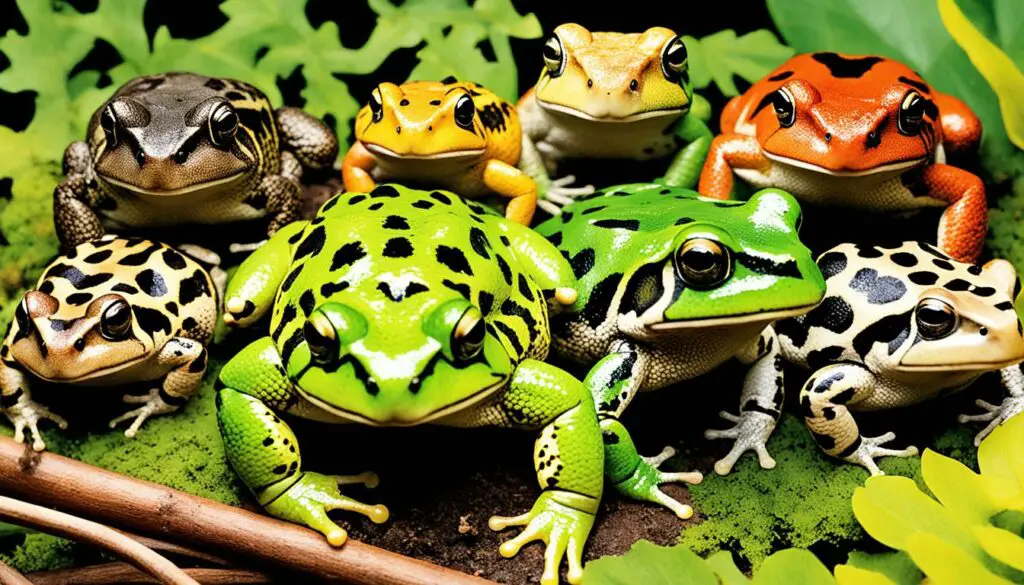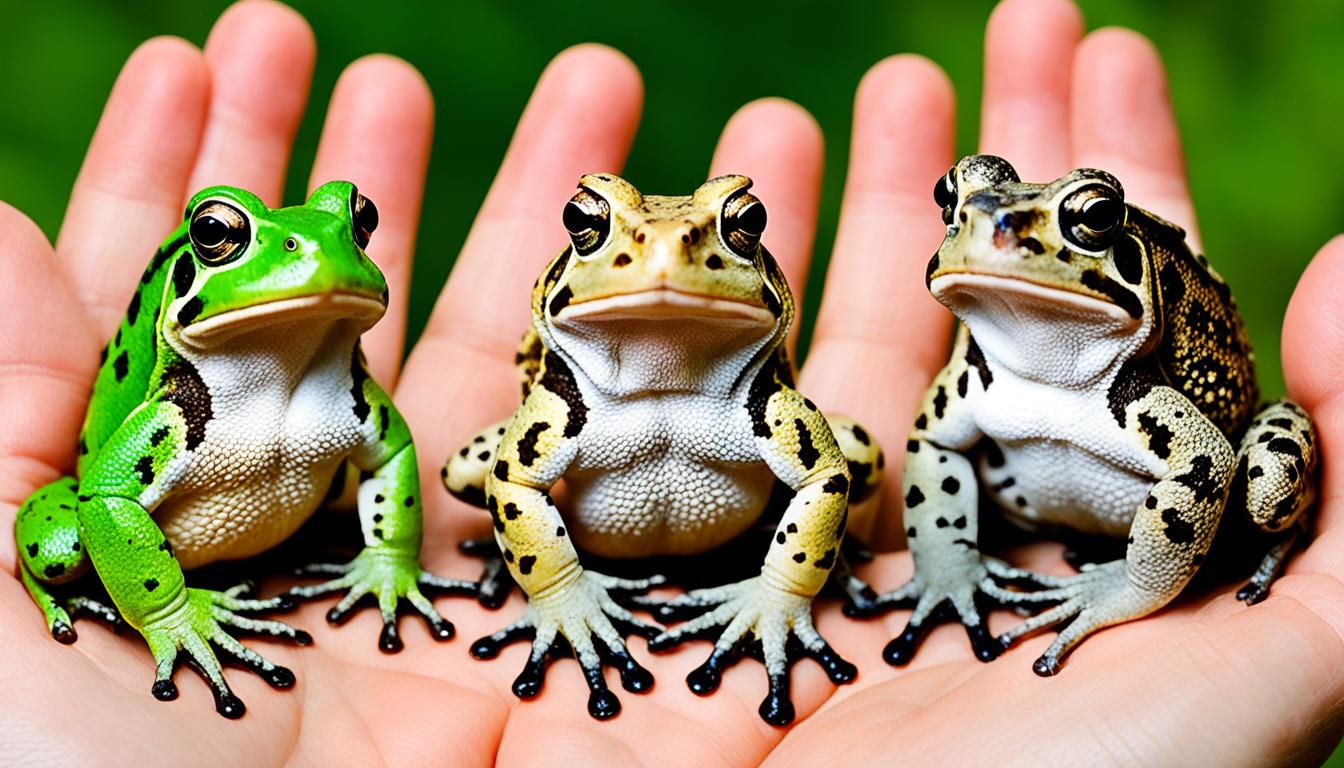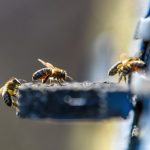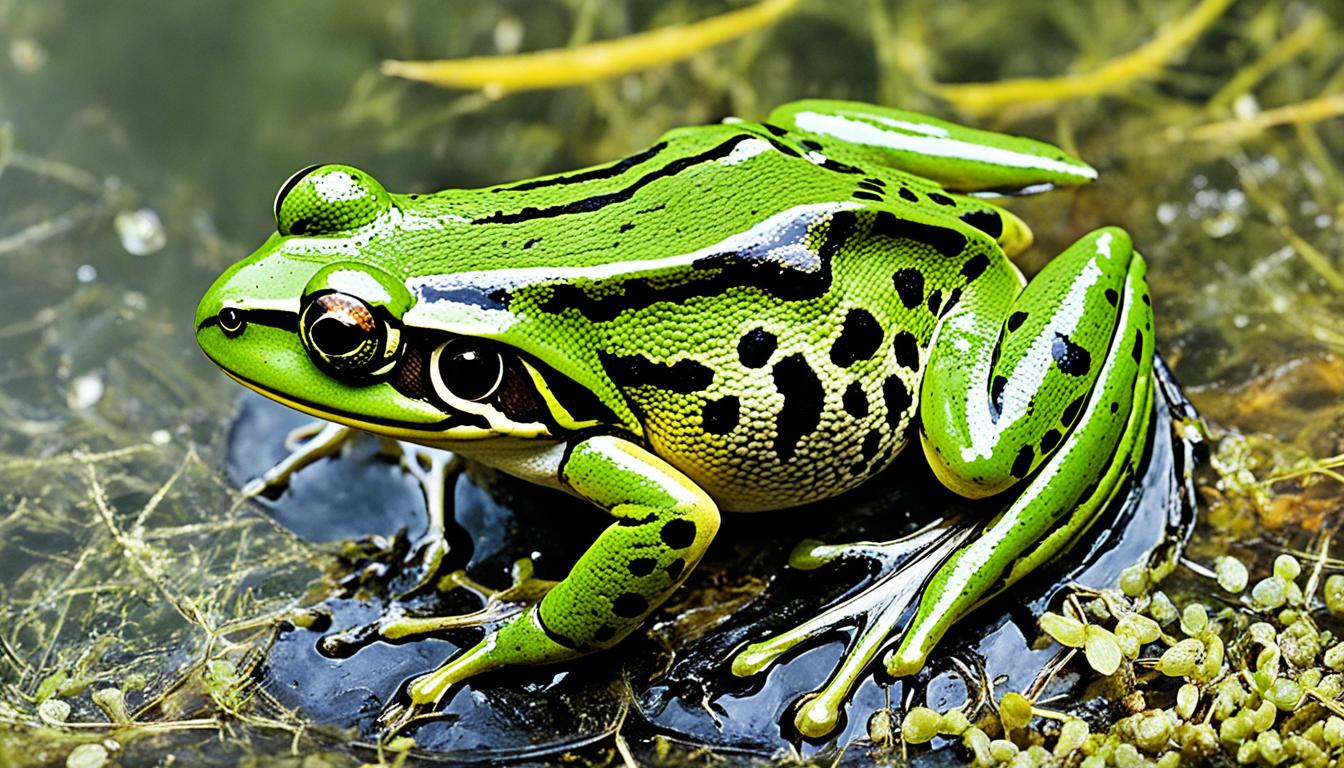Even experts in the USA find identifying toads challenging. The Anaxyrus genus is especially hard to tell apart. This often leads to mistakes on websites like iNaturalist.
Adding to the confusion is that toad species blend together at times. Hybrids can look like they belong to more than one species. This makes identifying them correctly even trickier.
This guide aims to help you understand the importance of knowing toad species exactly. Doing so requires careful observation in the field. When we can identify them well, we support the proper tracking and conservation of these toads.
Introduction to Toad Identification in the USA
Identifying toad species in the United States is key for everyone. Whether you love nature or are a science pro, spotting toads matters. It helps keep our area’s plant and animal records correct.
We will start by looking at what makes each toad type special. By checking out their looks, where they live, and small marks, it’s easier to tell them apart.
Looking closely at a toad’s skin, colors, and body is important. So is noticing unique parts like skull bumps or how warts are placed. This guide is here to help you get better at spotting different types of toads across America.
Getting toad IDs right is not just about learning. It’s a big deal for keeping our nature research correct and the toads safe. If you like helping with science or if it’s your job, knowing these tips will help.
General Physical Characteristics of Toads
Knowing about toad bodies helps us tell different toads apart. Each type of toad has its own special look. By really looking, we can spot differences between toads in America.
Skin Texture and Coloration
Toads have varied skin textures, from slick to bumpy and dry. Their colors also differ, even in the same toad kind. Sometimes, a toad’s color might change with the environment, but its skin texture stays the same. Because of this, we must look at many traits together when we try to figure out which toad is which.
Size and Body Shape
Young toads come in many different sizes and shapes. For example, Fowler’s Toad is quite small, while Eastern American Toads are bigger. Knowing these size and shape differences helps tell toads apart, both between and within species that look different because of their gender.
Leg and Jumping Habits
Looking at toads’ legs and how they jump helps too. Toads’ legs are usually shorter, and they don’t jump as much as frogs. Their jumping style is a key clue for identifying toad species. By watching toads leap, we can learn a lot about them.
To tell toad species apart in America, we need to know a lot about their bodies. Knowing about their skin, size, and how they move is key. This info helps us identify various toad species accurately as we explore the United States.
National Distribution Maps
National distribution maps are key for finding toad species by where they live. They show where specific toad species are usually found. They are also useful for knowing where you won’t find certain toad species. This makes it easier to figure out which toads you might see.
Common Toad Species in the USA
In the USA, commonly seen toads include the Eastern American Toad, Fowler’s Toad, and Southern Toad. Each toad type has a unique area it’s found in. For instance, the Eastern American Toad lives in the northeast. In contrast, Fowler’s Toad is in the central and eastern parts. The Southern Toad lives in the southeast.
Typical Habitats
Knowing where these toad species usually live can help with identification. Southern Toads like coastal plains with sandy soil. Meanwhile, Fowler’s Toads adapt to many places, like sandy areas, gardens, and wet spots. Eastern American Toads usually live in humid forests.
Combining maps with habitat knowledge boosts your ability to identify toad species. Such resources give crucial details on toad types and where they live. This info sets a good path for studying toads in the field.
Identifying Eastern American Toads
Spotting Eastern American Toads can be easy when you know what to look for. Their specific markings and where they live give them away.
Dorsal Spots and Warts
Looking at the toad’s back can tell you a lot. Eastern American Toads have small, round spots. They also have big warts that can be raised.
Distinctive Cranial Ridges
Eastern American toads have unique skull ridges. You can tell them apart because these ridges don’t touch their parotid gland. This is different from other toads in the U.S.
Geographic Range and Habitat
It’s key to know where they live for spotting these toads. They are mostly found in the eastern parts of the U.S. You can see them in forests, gardens, and fields.
But, they avoid some places too. So, knowing where they are not is important for their identification.
| Characteristic | Details |
|---|---|
| Dorsal Spots | Small, round, with occasional large warts |
| Cranial Ridges | Do not touch the parotid gland |
| Geographic Range | Eastern USA, excluding certain regions |
| Typical Habitat | Forests, gardens, and fields |
Characteristics of Fowler’s Toads
Fowler’s toads have unique traits that help with their identification. These traits set them apart from other kinds of toads. Knowing these differences makes identifying an American toad easier and more certain.
Spot and Wart Patterns
One key feature are the spots on their backs. These spots are big and not in any regular shape. They often cover many warts. This pattern is unique to Fowler’s Toads. It’s a big clue when trying to tell them apart from other toads.
Relationship Between Cranial Ridge and Parotid Gland
Another feature to look for is the way the cranial ridge meets the parotid glands. In Fowler’s Toads, the ridge usually goes right over the parotid glands. This is unlike many other toads. Paying attention to this can really help in identifying them correctly.
Regional Habitat Preferences
Fowler’s Toads also have certain places they like to live. They do well in sandy soil. You can find them all over, but not much in the Blue Ridge area. Knowing their preferred habitats can make spotting them easier.
| Characteristic | Fowler’s Toad | Other Toads |
|---|---|---|
| Dorsal Spots | Large, irregular | Smaller, more uniform |
| Cranial Ridge | Crosses parotid glands | Does not cross parotid glands |
| Habitat | Sandy soils, widespread | Varied habitats |
Southern Toad Identification Tips
Southern Toads have unique looks, mainly through their varied patterns and special skull features. Knowing these can really help in spotting different toad types in the U.S.
Pattern Variations
Southern Toads come in many pattern types. They might have no patterns at all, or they could have big, random spots. These patterns vary a lot, even in the same area.
Cranial Crests and Knobs
For Southern toad identification, look for cranial crests and knobs. Adult females show these off. The crests are on top of the head, and the knobs are in the middle.
Range and Environmental Requirements
Southern Toads usually live in the coastal plain, and then through to Southeastern Lunenburg County in the west. They love places with soft, sandy soil and lots of plants. This is key to knowing where and how to find them in the U.S.
Understanding Hybrid Toads
Hybrid toads are a mix of different toad species. They appear in places where many toad types live. This mixing makes it hard to clearly say which species they belong to.
Definition and Occurrence of Hybrids
When toads from different species mate, the offspring is a hybrid. This happens especially where these toad species share a living space. The blending of their genetics can make it difficult to tell them apart from the parent species.
Challenges in Hybrid Identification
Spotting hybrid toads is tough because toad species exist on a spectrum. Instead of being clearly different, they show a range of traits that mingle. Sometimes, we need to use genetic tests to know if a toad is a hybrid. This reality makes it important to fully understand toad diversity.
How do you identify different species of toads in the USA?

Figuring out the different toad species in the USA is fascinating but can be hard. You need to look at a toad’s looks and where it lives to know what it is.
First, check the skin texture and color. The color changes a lot, but the texture is more constant. Knowing if the skin is smooth or warty really helps in picking the right one.
Then, look at size and body shape. Some toads are small, like the Fowler’s Toad, and look different from others, like the Eastern American Toad. Their size and shape can be big clues.
Knowing where they live is key too. Maps show where each species is usually found. This can cut down on the types of toads it might be.
Also, look at cranial ridges and parotid glands. These parts vary and are unique to each species. For example, the cranial ridge and parotid gland look different in the Eastern American Toad and Fowler’s Toad.
“Field observations can significantly enhance your ability to identify different toad species in the USA, making detailed and accurate records possible.”
The places they live are important clues too. Toads can be in swampy areas or even city gardens. Knowing their habitat helps in spotting and naming the toads.
- Observe and document skin texture and coloration.
- Evaluate size and body shape for species clues.
- Utilize geographic distribution maps effectively.
- Examine cranial ridges and parotid gland positioning.
- Understand and note typical habitats.
Mixing all these points with watching toads closely makes it easier to name the different species in the USA.
Field Marks for Quick Toad Identification
Spotting toads in the wild is tricky, but certain tips make it easier. By carefully looking at their key traits, identifying toads becomes simpler. We’ll show you how to quickly tell one toad species from another.
Evaluating Dorsal Patterns
When you want to ID a toad fast, check out its back. Different toads have varied patterns, like spots, stripes, or blotches. These may differ in size, shape, and hue. For instance, American Toads have big warts in dark spots, while Fowler’s Toads have smaller warts in theirs.
Observing Skin Texture and Colors
Also, the toad’s skin texture and color can tell you a lot. American Toads are often recognized by their bumpy, warty skin. They come in shades from brown and olive to red. Their skin looks less wet than a frog’s, which is usually smooth and shiny.
Look closely at a toad’s chest and belly too. These areas can have unique marks that help with ID. Remember, changes in color can be because of the toad’s surroundings or the weather.
By focusing on back patterns and skin feel, you’ll become good at telling toads apart. These clues are essential during toad-watching, helping you identify many species confidently.
Role of Warting in Toad Identification
Warting is key in telling toad species apart. It is important in the toad species identification key, especially for those who study or love these creatures.
Importance of Wart Size and Distribution
Larger and more visible warts usually mean the toad is an adult. Smaller warts suggest a toad is younger. This helps in knowing not only the different types of toads but also their ages.
Warts are mainly on the back and legs of a toad. Some toads have warts that make a special pattern. This pattern is a big clue for figuring out what kind of toad it is. Looking at these patterns is better than just counting warts.
Differences in Warting Across Species
Each toad species has its own wart features. This can make telling them apart harder or easier. For example:
- American Toads: They often have few large warts, giving them a rough look.
- Fowler’s Toads: Their small warts are spread in a way that sometimes looks like big spots.
- Southern Toads: They have big warts and special head features, which makes them stand out.
Looking at the warts helps us understand important differences. Even if warts look different, they are still a good clue in the toad species identification key.
| Species | Wart Size | Wart Distribution |
|---|---|---|
| American Toad | Large | Uniform but fewer |
| Fowler’s Toad | Small | Irregular |
| Southern Toad | Medium to Large | Coupled with cranial crests |
Using wart size and placement can make toad identification better. It works well, even outside where toads live.
Special Considerations for Identifying Juvenile Toads
It’s tough to tell young toads apart from each other. They don’t yet have all the markings of grown toads. This makes finding out who they are quite hard. One big part of this is looking at how their heads are shaped. Sometimes, key details like these are very small or missing. So, figuring out the type of toad they are can be a real challenge.
Where you see a toad can help you figure out what kind it is. Young toads often hang out close to where they came from. This includes their overall location and the places they like to live. It helps cut down the list of possible matches. But, because they all often look similar, picking the right one from sight alone is tricky.
Even though young toads don’t look exactly like adults, we can still use some clues to help with their ID. We look at things like marks on their backs, how their legs are, and their size. These little hints, along with knowing where they are, greatly up our chances of getting their species right.
Conclusion: Mastering Toad Identification in the USA
Learning to identify toads in the USA means looking at their features closely. This includes their skin, color, and any markings on their back. Also, it’s about knowing where they usually live.
Looking at maps and learning about their habitats helps a lot. For example, if you know Southern Toads live near the coast, it makes it easier to identify them. Sometimes, toads can be a mix of different kinds, making things more interesting but also challenging.
Being part of projects like iNaturalist can make you really good at toad spotting. These projects help record plant and animal life in your area. Plus, they are a great way to double-check if you’ve identified a toad correctly. By using all these methods, you’ll be an expert at telling toads apart, and you’ll help science too.










